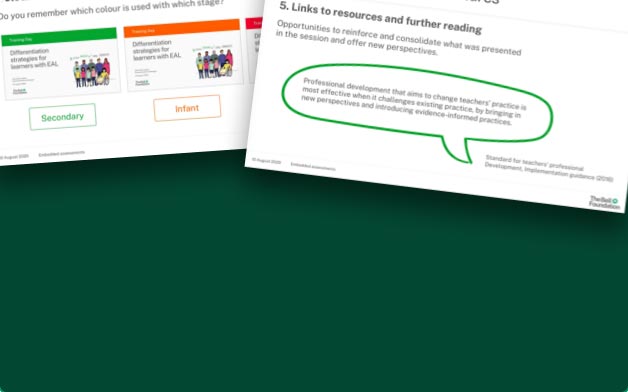Blog: EAL assessment – why it is important and how to assess EAL learners
Setting accurate language targets and using tailored strategies is crucial to helping EAL students settle back into school. This blog will explain why it is important, and advise on the best ways to assess multilingual learners.
Evidence on the impact of school closures on learners who use English as an Additional Language (EAL) showed that many students experienced learning loss and language learning loss during the period away from school. While the impact of the school holidays might not be as marked, some learners may find it difficult to return to the classroom and will require appropriate support.
However, labelling pupils simply as “EAL” can be too blunt a tool to understand their specific language learning needs. This is just one of the findings confirmed in a 2021 report – the fourth and last in a series investigating the relationships between EAL, proficiency in English and educational achievement at school (Strand & Lindorff, 2021).
As the report highlights, the term “EAL” does not provide any information on a pupil’s likelihood to succeed academically or what support they will need – precisely the information that schools need to target support effectively.
All four reports provide evidence on why understanding learners’ proficiency in English is a key factor in determining a pupil’s likelihood to fulfil their academic potential and why assessment of proficiency in English is so important. What have we learnt?
Key findings from the EAL reports
First, proficiency in English is central to understanding achievement and levels of need among pupils who use EAL. It can explain 22 per cent of the variation in EAL pupils’ achievement, compared with the three to four per cent that can be explained using gender, free school meal status and ethnicity.
Second, there are positive associations between being competent and fluent in the language of instruction at school and educational achievement, whereas low proficiency in the language of instruction can be a barrier to achievement. Using the bands originally provided by the Department for Education (DfE), the research demonstrates that EAL pupils who are New to English or at the Early Acquisition stage score below the national average, those who are Developing Competence are very close to the national average, and those with the highest levels of proficiency (Competent or Fluent) typically score higher than first language English speakers.
Third, pupils entering the English school system as New to English, at whatever age, may need at least six years of support before they reach the highest levels of proficiency in English, at which point they can fully access the curriculum and achieve their academic potential.
Fourth, schools and local authorities vary substantially in how they assess proficiency in English. As a result, there is a marked variation in the average time it takes pupils to progress between proficiency in English levels. Also, the judgement of proficiency in English and the time in which learners progress across levels is strongly influenced by the individual making the assessment, rather than reflecting a difference in the pupils themselves.
In addition, the most recent report includes the following key findings:
- There is no negative association between the number of EAL learners in a school and the levels of achievement for other pupils in the school.
- Secondary schools tend to recode some EAL pupils, particularly those learners who are fully fluent in English, as monolingual English/Welsh (since the Welsh government has continued to record proficiency in English data, Strand’s report analysed data from the Welsh Pupil Level Annual School Census). This suggests some conflation of the term “EAL” with “needing language support”.
So, how can the conclusions from the research be applied to practice in schools?
What schools can do to support EAL learners
Perhaps the most important insight is that the term EAL is not a sufficient measure of a pupil’s need for language support. It follows, then, that this need should be accurately identified, so that tailored support for individual pupils can be set.
Here are three strategies that schools can adopt to ensure on-going, consistent and reliable teacher assessment of proficiency in English, which would benefit all learners who use EAL.
1. Implement a thorough initial assessment
If schools can accurately establish a learner’s level of proficiency in English as well as gain some understanding of their cognitive skills and proficiency in other languages, during initial and on-going assessment, then they are better able to determine the length and type of support required to meet the learner’s language development needs.
Each learner brings with them a distinct skill-set. The subjects they already have a flair for, their cognitive skills and their fluency in their home language all play a significant part, but proficiency in English remains the clearest determinant of attainment.
When conducting initial assessment of pupils’ proficiency in English, it can be beneficial for schools to take the following suggestions into account:
Collect useful background information: The initial induction meeting is a great opportunity to gain a more complete picture of the learner, which will help to inform an appropriate course of action. Where language support is needed, consider using an interpreter if possible, or translation tool, such as the online background collation tool for new arrivals from SEGfL. You might want to ask about:
- The learner’s previous experience of education.
- The languages they use and their levels of literacy in them.
- Their knowledge of English.
More information can be found in the guidance section on this website.
Monitor progression through the bands: In the absence of nationally agreed criteria and descriptors for different levels of proficiency in English, schools should adopt robust EAL assessment tools to generate useful formative assessment information.
Schools should assess learners’ progress at regular intervals, update records, and use these data to monitor progression through the bands. Consider that the majority of pupils take more than six years to progress to the highest levels of proficiency if they enter the school system as New to English.
Accurate proficiency in English data is of particular significance on entering secondary education when the urgency of examinations increases the need for academic English.
Slower than expected progress requires investigation: the learner may need greater support with their language learning, or they may have other additional educational needs. Schools are reminded that funding for EAL is limited to up to three years after a learner enters the school system in England and is not ring-fenced (EFA, 2020).
Monitor patterns in data: Use data from proficiency in English assessments alongside other core data (e.g. gender, ethnicity, Pupil Premium, specific language groups) to monitor rates of progress among groups of students, including those identified as the most likely to take longer to reach the higher levels of proficiency. Hutchinson (2018) highlights the variation in attainment by arrival time and by first language. Variations in rates of progress need to be investigated and, where necessary, impactful language-focused interventions put in place. This is particularly true now as schools continue to consider the impact of both learning and language loss following extended periods of remote learning.
2. Use robust EAL assessment tools
Robust assessment tools will ensure consistency in how teachers undertake assessment and will go some way to reducing subjectivity. Using an EAL assessment framework gives practitioners a shared understanding of different levels of proficiency within the context of curriculum learning and provides a roadmap for progress.
The Bell Foundation’s free, evidence-informed EAL Assessment Framework for Schools can be used for initial and on-going assessments. The following recommendations can support an effective whole-school approach to assessing an EAL learner’s progression:
Share the responsibility for assessments: By saving assessments centrally and creating a system whereby different members of staff can input their findings from classroom tasks, a broader and more accurate record of the proficiency level of the learner, in all four strands of language use (listening, speaking, reading and viewing, and writing), will emerge. This is particularly true in subjects with very specific language demands, for example, the language of hypothesis in science.
Share language targets: Knowledge of a learner’s language targets across subjects can inform planning. For example, if a secondary school learner has a target to “follow reasoning, discussion or argument in English”, and different subject teachers are aware of this target, they will then be able to include structured collaborative tasks in their lessons which provide opportunities to give practice with this.
A primary school speaking target from Band C might be "Can use vocabulary that has been introduced on tasks and in taught sessions." You might be able to plan collaborative tasks which require learners to recall and consolidate their spoken use of new subject specific language, for example, comparing life in different countries in a geography lesson.
3. Provide training and implement moderation
Given that assessment of proficiency in English is strongly influenced by the individual making the assessment, schools should take steps to minimise subjectivity and variation between individual assessors to ensure reliable assessment of pupils’ proficiency in English.
Engaging in high-quality CPD on how to assess proficiency in English and putting in place robust moderation procedures will support consistent and reliable teacher assessment.
To ensure reliability, implement cross-team moderation. Robust moderation procedures across faculties and between schools, which might include, for example, sharing annotated examples of language use from different subjects, will ensure staff are more confident and consistent in their allocation of descriptors and targets.
We can also ensure reliability by encouraging regional moderation. Links between schools through local authorities or independent groups, for example, could be exploited to facilitate moderation on a wider scale, and thereby help eliminate inconsistencies in the allocation of bands.
Conclusion
By assessing learners’ proficiency in English, schools will be in a strong position to ensure that learners using EAL can fully access the curriculum and can make sufficient progress to allow them to demonstrate their understanding in assessments.
Setting accurate language targets and implementing the relevant strategies to support learners will be key to reducing the learning gap experienced by many EAL learners.
This article first appeared in Headteacher Update and SecEd on 23 March 2021.
Resources:
- New Arrivals (guidance)
- EAL learners with Special Educational Needs or Disabilities (guidance)
- EAL Assessment Framework for Schools
- EFA: Schools revenue funding 2020 to 2021: Operational guide, February 2020
- Hutchinson: Educational Outcomes of Children with English as an Additional Language, The Bell Foundation, Unbound, EPI, February 2018
- Strand & Lindorff: English as an additional language, proficiency in English and rate of progression: Pupil, school and LA variation, University of Oxford, Unbound, The Bell Foundation, March 2021
- SEGfL: Online background collation tool for new arrivals

